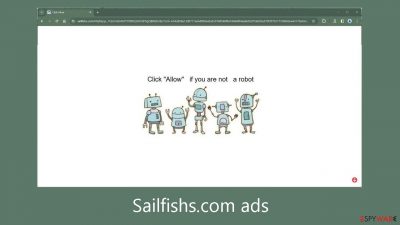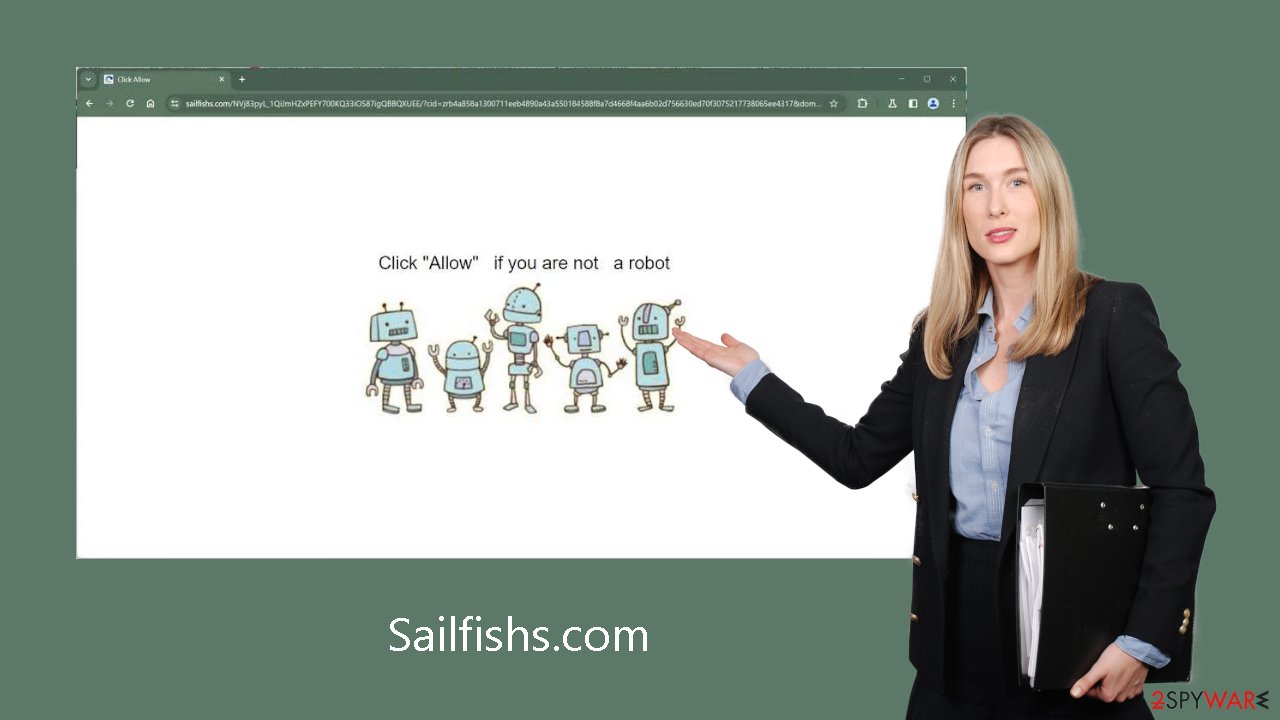Sailfishs.com ads (spam) - Free Guide
Sailfishs.com ads Removal Guide
What is Sailfishs.com ads?
Sailfishs.com is a dubious site created for the purpose of tricking everyday users

Sailfishs.com is a deceptive website designed by crooks to generate income through pay-per-click advertising. The website uses social engineering techniques[1] to trick visitors into signing up for push notifications by asking them to click the “Allow” button in order to verify that they are not robots.
Users get a deluge of bothersome pop-up advertisements after granting permission, which continue to show even when the browser is closed. Fraudsters may also take advantage of rogue ad networks[2] to show advertisements that direct viewers to dangerous websites. These embedded links may take users to bogus pages when they click on them.
Attempts to obtain personal information, lure users into downloading potentially unwanted programs (PUPs),[3] and even spread malware are just a few of the strategies that crooks may utilize. Ads for adult websites, fake antivirus software, software deals, surveys, and phony giveaways have reportedly been seen by certain users.
| NAME | Sailfishs.com |
| TYPE | Push notification spam; adware |
| SYMPTOMS | Annoying pop-up ads start appearing in the corner of the screen, sometimes even when the browser is closed |
| DISTRIBUTION | Shady websites, deceptive ads, freeware bundling |
| DANGERS | Links embedded in the pop-ups may lead to dangerous pages where people can get tricked into providing their personal information or downloading PUPs and malware |
| ELIMINATION | Disable push notifications via browser settings |
| FURTHER STEPS | Use a maintenance tool like FortectIntego to clear your browsers from cookies and cache |
Distribution methods
Websites like Sailfishs.com are rarely found in search results; instead, they are usually hidden among unofficial and questionable websites. Particularly illegal streaming services are well-known for running deceptive adverts and secret redirects. These websites might even display fake “Download” and “Play” buttons, tricking gullible viewers into opening new tabs.
Limiting your online visits to well-known and reliable websites is advised. Refrain from randomly clicking on links and advertisements, even if they seem to recommend trustworthy goods and services. Choose trustworthy streaming services like Hulu or Netflix, which have a low monthly membership cost and provide customers with limitless access to a wide variety of content.

Protect your privacy
The vast majority of websites you visit will ask for your consent before using cookies. These tiny data files have the ability to collect data on your IP address, location, websites you've visited, links you've clicked, and online transactions. Typically, this practice enhances the personalization of the user experience.
On the other hand, fraudsters might use this information for financial advantage. Cookies can be sold to advertising networks or other third parties. When websites are visited that don't have strong security, cookies can be taken over and utilized maliciously. Thus, it becomes essential to clean your browser on a regular basis.
Using a maintenance tool like FortectIntego, which can automate the removal of all cookies and cache with a single click, will streamline this process. Moreover, it can resolve registry difficulties, corrupted files, BSODs, errors, and other system issues; this is an especially useful feature after a virus infection.
How to disable pop-ups?
The first thing you should do is go to your browser settings and see if you can disable the push notifications from there:
Google Chrome (desktop):
- Open Google Chrome browser and go to Menu > Settings.
- Scroll down and click on Advanced.
- Locate Privacy and security section and pick Site Settings > Notifications.
![Stop notifications on Chrome PC 1 Stop notifications on Chrome PC 1]()
- Look at the Allow section and look for a suspicious URL.
- Click the three vertical dots next to it and pick Block. This should remove unwanted notifications from Google Chrome.
![Stop notifications on Chrome PC 2 Stop notifications on Chrome PC 2]()
Google Chrome (Android):
- Open Google Chrome and tap on Settings (three vertical dots).
- Select Notifications.
- Scroll down to the Sites section.
- Locate the unwanted URL and toggle the button to the left (Off setting).
![Stop notifications on Chrome Android Stop notifications on Chrome Android]()
Mozilla Firefox:
- Open Mozilla Firefox and go to Menu > Options.
- Click on Privacy & Security section.
- Under Permissions, you should be able to see Notifications. Click the Settings button next to it.
![Stop notifications on Mozilla Firefox 1 Stop notifications on Mozilla Firefox 1]()
- In the Settings – Notification Permissions window, click on the drop-down menu by the URL in question.
- Select Block and then click on Save Changes. This should remove unwanted notifications from Mozilla Firefox.
![Stop notifications on Mozilla Firefox 2 Stop notifications on Mozilla Firefox 2]()
Safari:
- Click on Safari > Preferences…
- Go to the Websites tab and, under General, select Notifications.
- Select the web address in question, click the drop-down menu and select Deny.
![Stop notifications on Safari Stop notifications on Safari]()
MS Edge:
- Open Microsoft Edge, and click the Settings and more button (three horizontal dots) at the top-right of the window.
- Select Settings and then go to Advanced.
- Under Website permissions, pick Manage permissions and select the URL in question.
![Stop notifications on Edge 1 Stop notifications on Edge 1]()
- Toggle the switch to the left to turn notifications off on Microsoft Edge.
MS Edge (Chromium):
- Open Microsoft Edge, and go to Settings.
- Select Site permissions.
- Go to Notifications on the right.
- Under Allow, you will find the unwanted entry.
- Click on More actions and select Block.
Adware removal
It is possible that adware remains hidden in your system and appears as a barrage of advertisements, pop-ups, surveys, and redirects, even after you have disabled notifications. If you notice any of these signs, we highly advise using specialized security tools like SpyHunter 5Combo Cleaner or Malwarebytes to perform a comprehensive scan.
Software that detects and removes suspicious programs from your computer is skilled at getting rid of all related files. Additionally, it acts as a safeguard by warning you of possible dangers during dubious downloads. Manual removal is an alternative, but it can be difficult to recognize potentially unwanted programs (PUPs) because they frequently pose as media players, antivirus software, or system optimizers, among other seemingly helpful utilities.
Additionally, manual removal may inadvertently leave behind related files and entries, leading to a resurgence of the infection. Nevertheless, comprehensive instructions for both Windows and Mac systems are given below if you would rather remove it manually:
Windows 10/8:
- Enter Control Panel into Windows search box and hit Enter or click on the search result.
- Under Programs, select Uninstall a program.
![Uninstall from Windows 1 Uninstall from Windows 1]()
- From the list, find the entry of the suspicious program.
- Right-click on the application and select Uninstall.
- If User Account Control shows up, click Yes.
- Wait till uninstallation process is complete and click OK.
![Uninstall from Windows 2 Uninstall from Windows 2]()
Windows 7/XP:
- Click on Windows Start > Control Panel located on the right pane (if you are Windows XP user, click on Add/Remove Programs).
- In Control Panel, select Programs > Uninstall a program.
![Uninstall from Windows 7/XP Uninstall from Windows 7/XP]()
- Pick the unwanted application by clicking on it once.
- At the top, click Uninstall/Change.
- In the confirmation prompt, pick Yes.
- Click OK once the removal process is finished.
Mac:
- From the menu bar, select Go > Applications.
- In the Applications folder, look for all related entries.
- Click on the app and drag it to Trash (or right-click and pick Move to Trash)
![Uninstall from Mac 1 Uninstall from Mac 1]()
To fully remove an unwanted app, you need to access Application Support, LaunchAgents, and LaunchDaemons folders and delete relevant files:
- Select Go > Go to Folder.
- Enter /Library/Application Support and click Go or press Enter.
- In the Application Support folder, look for any dubious entries and then delete them.
- Now enter /Library/LaunchAgents and /Library/LaunchDaemons folders the same way and terminate all the related .plist files.
![Uninstall from Mac 2 Uninstall from Mac 2]()
How to prevent from getting adware
Access your website securely from any location
When you work on the domain, site, blog, or different project that requires constant management, content creation, or coding, you may need to connect to the server and content management service more often. The best solution for creating a tighter network could be a dedicated/fixed IP address.
If you make your IP address static and set to your device, you can connect to the CMS from any location and do not create any additional issues for the server or network manager that needs to monitor connections and activities. VPN software providers like Private Internet Access can help you with such settings and offer the option to control the online reputation and manage projects easily from any part of the world.
Recover files after data-affecting malware attacks
While much of the data can be accidentally deleted due to various reasons, malware is one of the main culprits that can cause loss of pictures, documents, videos, and other important files. More serious malware infections lead to significant data loss when your documents, system files, and images get encrypted. In particular, ransomware is is a type of malware that focuses on such functions, so your files become useless without an ability to access them.
Even though there is little to no possibility to recover after file-locking threats, some applications have features for data recovery in the system. In some cases, Data Recovery Pro can also help to recover at least some portion of your data after data-locking virus infection or general cyber infection.
- ^ Social Engineering. Imperva. Learning Center.
- ^ Zeljka Zorz. How does a rogue ad network function?. Helpnetsecurity. Information Security Blog.
- ^ Chris Hoffman. PUPs Explained: What is a “Potentially Unwanted Program”?. Howtogeek. Technology Magazine.












